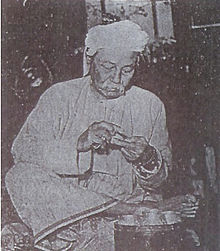Thakin Kodaw Hmaing
| Thakin Kodaw Hmaing | |
|---|---|
 |
|
| Born |
Maung Lun Maung March 23, 1876 Walei Village, near Shwedaung, Pyay District, Kingdom of Myanmar |
| Died | July 23, 1964 (aged 88) Yangon, Myanmar |
| Resting place | Kandawmin Garden Mausolea, Yangon, Burma (Myanmar) |
| Pen name | Pandi Lay, Maung Sammadi, Saya Lun, Bow Bow Aung, Mr. Maung Hmaing, Thakin Kodaw Hmaing |
| Occupation | dramatist, poet, journalist, politician |
| Period | 1898–1964 |
| Genre | Nationalist |
| Notable works | Missata Maung Hmaing Hmadawbon Wuttu 1916 |
| Notable awards | Stalin Peace Prize (1954), Honorary Doctorate, University of Hamburg (1960) |
| Spouse | Ma Shin (1903–1913) |
Thakin Kodaw Hmaing (Burmese: သခင်ကိုယ်တော်မှိုင်း, pronounced: [θəkʰɪ̀ɴ kòdɔ̀ m̥áiɴ]; 23 March 1876 – 23 July 1964) is considered one of the greatest Burmese poets, writers and political leaders in the 20th century history of Burma. He is regarded as the Father of Burmese nationalist and peace movements as well as a literary genius. His legacy and influence on the post-war generations can still be felt in both literature and the ongoing political situation in Myanmar (Burma).
Hmaing was born Maung Lun Maung in Wale village near Shwedaung in Lower Burma. He was sent at an early age to be educated in the traditional manner in Mandalay, and at the age of 9 he witnessed the fall of the Konbaung dynasty and the abduction of King Thibaw and Queen Supayalat by the British, being taken away in a carriage, near the queen's own Myadaung Monastery where he was a boarder. It was a scene that he would never forget and one that sparked his nationalist fervour in a lifelong struggle for independence.
In 1894 Hmaing moved to Rangoon (now Yangon) to start his career as a playwright, and switched to journalism later on writing articles for a newspaper in Moulmein (now Mawlamyaing). In 1903 he married Ma Shin whom he had met in Rangoon before moving to Moulmein, and returned to the capital as the nationalist movement was gaining momentum in 1911 to work for the Thuriya (Sun) newspaper. Writing under his own name Maung Lun or Saya Lun, he had already reached a wide audience by now through traditional stage plays written in verse and based on historical Burmese myth and legend. He contributed regularly to the paper and other publications such as the Dagon magazine where he later became an editor.
...
Wikipedia
